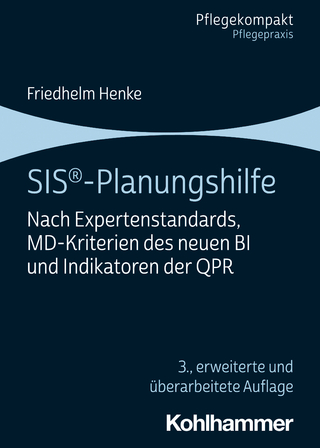
Lippincott Essentials for Nursing Assistants
Wolters Kluwer Health (Verlag)
978-1-9751-4257-5 (ISBN)
- Titel erscheint in neuer Auflage
- Artikel merken
Ideal for use in shorter, fast-paced programs, each chapter focuses on only the most essential concepts, breaking down information into segments for easier retention. Author Pamela Carter’s conversational, yet professional writing style clarifies complex material to make information more accessible. Helpful Procedures and Guidelines boxes provide step-by-step walkthroughs for common tasks and detail the rationale behind key procedure actions in order to enhance understanding and strengthen clinical decision-making capabilities.
The 5th edition has been revised and updated to reflect today’s changing healthcare practices — including the latest NNAAP® skill revisions and features callouts to Lippincott Acute Care Skills for Advanced Nursing Assistants, a companion ebook-only text by Pamela Carter that highlights advanced skills and situations that may call for additional training as students advance through their nursing assistant careers.
UNIT ONE: INTRODUCTION TO HEALTH CARE
Chapter 1: The Health Care System
A Holistic Approach to Health Care
Health Care Organizations
Patients, Residents, and Clients
Oversight of the Health Care System
Paying for Health Care
Chapter 2: The Nursing Assistant’s Job
Education of the Nursing Assistant
The Nursing Assistant as a Member of the Nursing Team
Legal and Ethical Aspects of the Nursing Assistant’s Job
Chapter 3: Professionalism and Job-Seeking Skills
Working as a Professional
Finding a Job
Chapter 4: Communication Skills
Introduction to Communication
Communicating with People with Special Needs
Resolving Conflicts
Using the Telephone
Communication Among Members of the Health Care Team
Chapter 5: Those We Care For
Growth and Development
Basic Human Needs
Human Sexuality and Intimacy
Culture and Religion
What is it Like to be a Patient or Resident
Chapter 6: The Patient’s or Resident’s Environment
The Physical Environment
Furniture and Equipment
Adapting the Environment to the Individual
UNIT TWO: THE HUMAN BODY IN HEALTH AND DISEASE
Chapter 7: Basic Body Structure and Function
How is the Body Organized?
The Integumentary System
The Musculoskeletal System
The Respiratory System
The Cardiovascular System
The Nervous System
The Sensory System
The Endocrine System
The Digestive System
The Urinary System
The Reproductive System
Chapter 8: Common Disorders
Introduction to Disorders
Integumentary Disorders
Musculoskeletal Disorders
Respiratory Disorders
Cardiovascular Disorders
Nervous System Disorders
Sensory Disorders
Endocrine Disorders
Digestive Disorders
Urinary Disorders
Reproductive Disorders
Mental Health Disorders
Chapter 9: Rehabilitation and Restorative Care
Introduction to Rehabilitation and Restorative Care
Types of Rehabilitation
The Role of the Nursing Assistant
UNIT THREE: LONG-TERM CARE
Chapter 10: Overview of Long-Term Care
Types of Long-Term Care Settings
Long-Term Care: Past, Present, and Future
Oversight of Long-Term Care
Paying for Long-Term Care
Chapter 11: The Long-Term Care Resident
Our Aging Population
Factors Leading to Long-Term Care Admissions
Making the Adjustment to Long-Term Care
Living with a Chronic Condition
The Young Resident
Quality of Life in the Long-Term Care Setting
Chapter 12: Caring for People With Dementia
Introduction to Dementia
Types of Dementia
The “Four A’s” of Dementia
Behaviors Associated with Dementia
Caring for a Person With Dementia
Effects on the Caregiver
UNIT FOUR: SAFETY
Chapter 13: Infection Control
Causes of Infection
Defenses Against Infection
Ways Infections are Transmitted
The Chain of Infection
Methods of Infection Control
Occupational Safety and Health Administration (OSHA) Bloodborne Pathogens Standard
Chapter 14: Workplace Safety
Protecting Your Body
Following Procedures
Fire Safety
Preventing Chemical and Electrical Injuries
Disaster Preparedness
Workplace Violence
Chapter 15: Patient and Resident Safety
Accidents and Incidents in the Health Care Setting
Restraints and Restraint Alternatives
Chapter 16: Basic First Aid and Emergency Care
Responding To An Emergency
Basic Life Support (BLS) Measures
Emergency Situations
UNIT FIVE: BASIC PATIENT AND RESIDENT CARE
Chapter 17: Assisting With Repositioning and Transferring
Assisting With Repositioning
Assisting With Transferring
Chapter 18: Assisting With Exercise
Assisting With Walking (Ambulation)
Assisting With Range-of-Motion Exercises
Chapter 19: Bedmaking
Linens
Standard Bedmaking Techniques
Chapter 20: Measuring and Recording Vital Signs, Height, and Weight
Introduction to Vital Signs
Body Temperature
Pulse
Respiration
Blood Pressure
Height and Weight
Chapter 21: Assisting With Hygiene
Introduction to Personal Hygiene
Assisting with Oral Care
Assisting with Perineal Care
Assisting with Bathing
Chapter 22: Preventing Pressure Ulcers and Assisting With Wound Care
Preventing Pressure Ulcers
Assisting With Wound Care
Chapter 23: Assisting With Grooming
Introduction to Grooming
Assisting with Hand Care
Assisting With Foot Care
Assisting with Dressing and Undressing
Assisting with Hair Care
Assisting with Shaving
Assisting with Vision and Hearing Accessories
Chapter 24: Assisting With Nutrition
Introduction to Nutrition
Factors that Affect Food Choices and Eating Habits
Special Diets
Assisting With Meals
Assisting With Fluids
Alternative Ways of Providing Nutrition and Fluids
Monitoring Blood Glucose Levels
Chapter 25: Assisting With Urinary Elimination
Introduction to Urinary Elimination
Assisting With Bedside Commodes, Bedpans, and Urinals
Caring for a Person With an Indwelling Urinary Catheter
Caring for a Person Who is Incontinent of Urine
Obtaining a Urine Specimen
Measuring Urine Output
Chapter 26: Assisting With Bowel Elimination
Introduction to Bowel Elimination
Problems With Bowel Elimination
Obtaining a Stool Specimen
Assisting With Enemas
Assisting With Ostomy Care
Chapter 27: Assisting With Comfort and Rest
General Comfort Measures
Managing Pain
Heat and Cold Applications
UNIT SIX: SPECIAL CARE CONCERNS
Chapter 28: Caring for People Who Are Dying
Terminal Illness
Advance Directives and Wills
Attitudes Toward Death and Dying
Care and Support of the Dying Person and the Family
Postmortem Care
Chapter 29: Caring for People with Developmental Disabilities
Introduction to Developmental Disabilities
Education and Protection of Rights
Caring for People With Developmental Disabilities
Chapter 30: Caring for People with Cancer
Introduction to Cancer
Detecting and Treating Cancer
Caring for a Person with Cancer
Chapter 31: Caring for People with HIV/AIDS
Introduction to HIV/AIDS
Attitudes Toward People With HIV/AIDS
Caring for a Person with HIV/AIDS
Chapter 32: Caring for People Who Are Having Surgery
Introduction to Surgery
Pre-Operative Care
Intra-Operative Care
Post-Operative Care
Oxygen Therapy
Chapter 33: Caring for People in the Home Environment
Introduction to Home Health Care
The Home Health Aide
The Home Health Care Environment
Infection Control
Appendix A: Answers to What Did You Learn? Questions
Appendix B: Introduction to the Language of Health Care
Glossary
Index
| Erscheinungsdatum | 18.07.2023 |
|---|---|
| Sprache | englisch |
| Maße | 213 x 276 mm |
| Gewicht | 1769 g |
| Themenwelt | Medizin / Pharmazie ► Pflege |
| ISBN-10 | 1-9751-4257-8 / 1975142578 |
| ISBN-13 | 978-1-9751-4257-5 / 9781975142575 |
| Zustand | Neuware |
| Haben Sie eine Frage zum Produkt? |
aus dem Bereich



